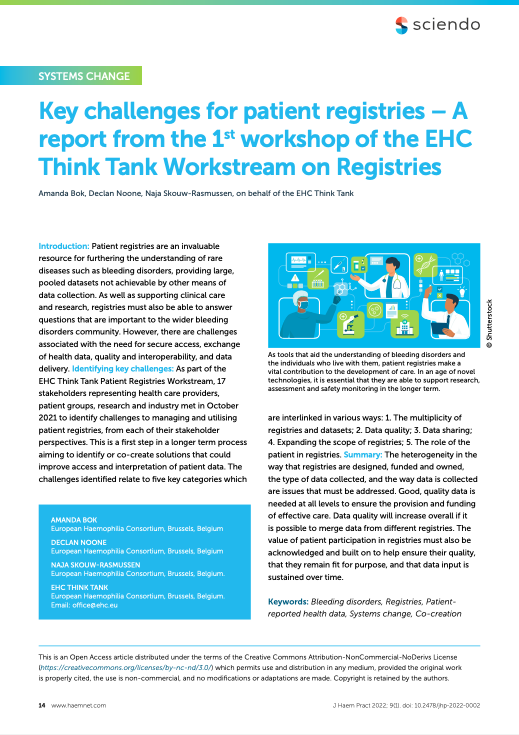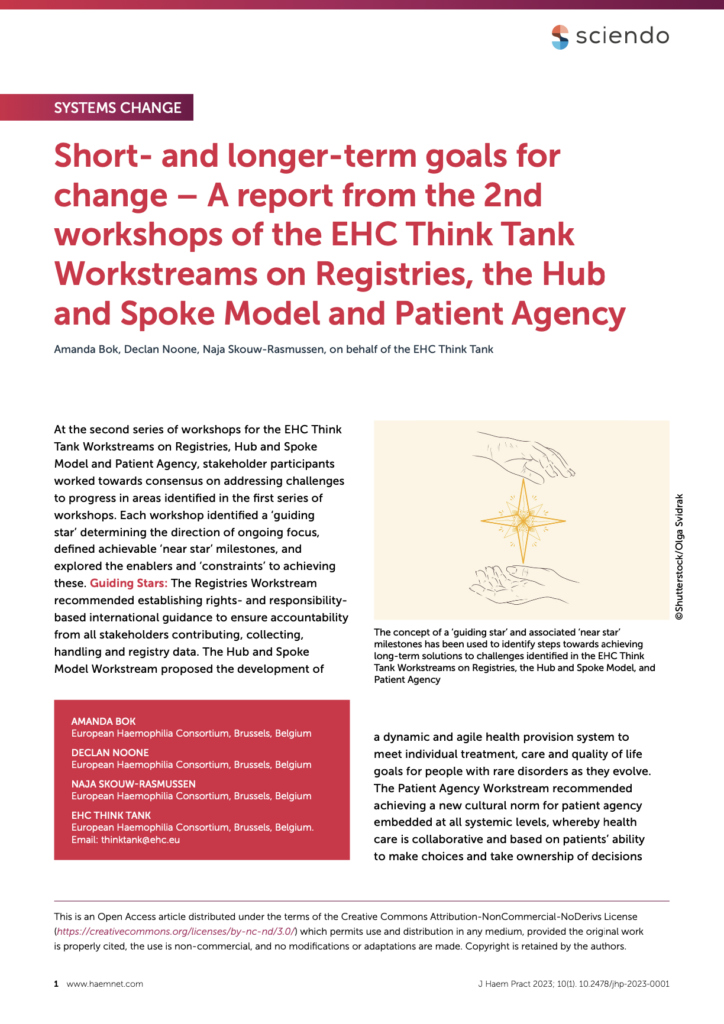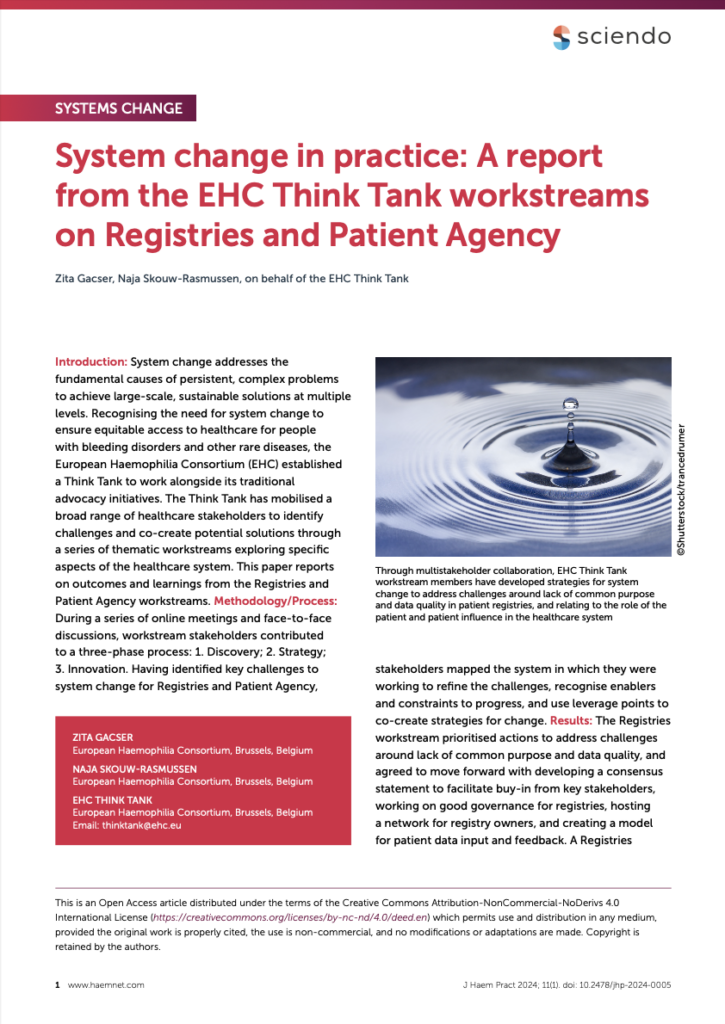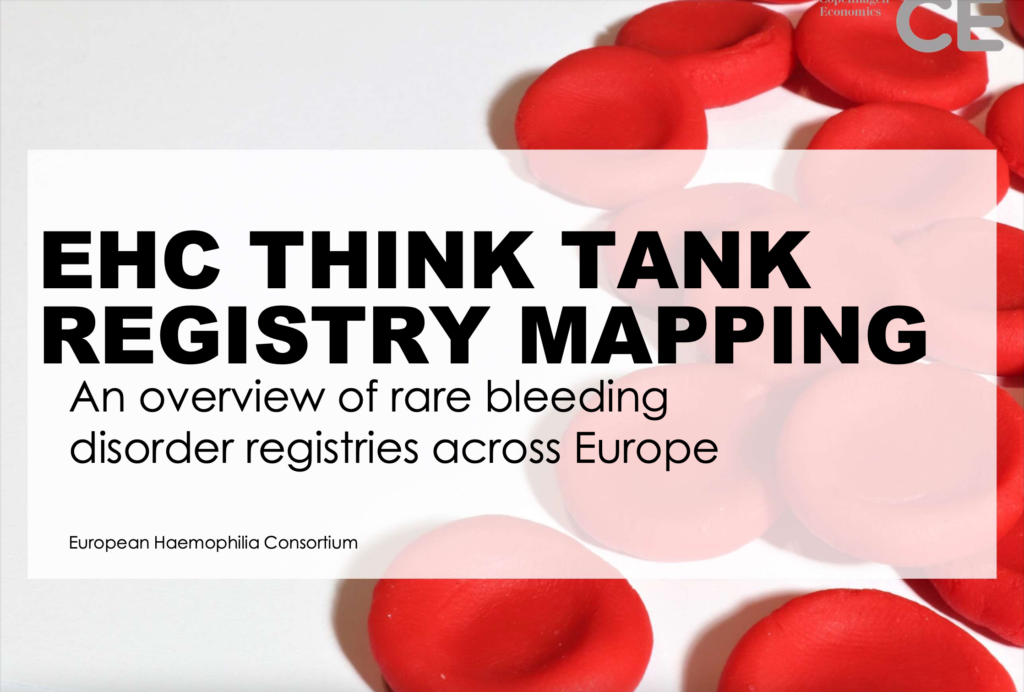The Registries workstream seeks to untangle the complexities of registries, to find common ground, and to co-construct a collectively endorsed forward direction. It focuses on challenges such as data sharing, multiplicity of registries, ownership, and the overall purpose of registries.
About the workstream
Registries constitute key instruments to increase knowledge on bleeding disorders for patients, healthcare professionals, payers, insurance companies, researchers, and policy makers. Registries can include epidemiology of the disorder, demonstrate efficacy of different management and therapeutic options, and be a significant enabler for clinical research. Some of the central issues with national and pan-national registries to address include principles for data collection, funding sustainability, ownership and access to data, lack of interconnectivity, and real-world evidence integration.
This workstream seeks to better untangle the complexities of this area, to find common ground, and to co-construct a collectively endorsed forward direction.
Composition
The composition of the workstream aims to reflect the diversity of key actors who have hands-on knowledge of challenges and possible solutions in this thematic area. This includes, but is not limited to: patients, healthcare professionals, industry partners, private companies, policymakers, researchers, and academics.
The general membership profile is built around required skill sets and may evolve throughout the co-creation process. The initial skill sets include the ability to ‘problem map’ salient points and their relationships, requiring:
- Hands-on knowledge of the topic area,
- Genuine willingness to learn about, and actively contribute to, a systems change culture,
- Experienced, analytical, open, hands-on ability to remove stakeholder ‘hats’, and
- Respect of Chatham House Rule and culture of conduct and engagement.
Each workstream brings together 16-20 individuals, which is broad enough to ensure a comprehensive overview, while small enough to be workable.
Workload
The mandate duration and meeting cadence are due to change based on collective needs and decisions. However, the preliminary anticipated commitment is three to four (3-4) hours per meeting, once a semester, trimester or quarterly, subject to the above collective decision.
The workstream met for the first time in Q4 2021.
Public outcome
- As part of sharing the outcome of the work of the EHC Think Tank, the first paper from the workstream on registries in which workstream members identify key challenges concerning registries is now published. This paper is the first in a series of outcomes aiming to synthesise how we might change registries. Bok A, Noone D, Skouw-Rasmussen N, EHC Think Tank. Key challenges for patient registries – A report from the 1st workshop of the EHC Think Tank Workstream on Registries. The Journal of Haemophilia Practice. 2022;9(1): 14-19. https://doi.org/10.2478/jhp-2022-0002
- At the second series of workshops for the EHC Think Tank Workstreams on Registries, Hub and Spoke Model and Patient Agency, stakeholder participants worked towards consensus on addressing challenges to progress in areas identified in the first series of workshops. Each workshop identified a ‘guiding star’ determining the direction of ongoing focus, defined achievable ‘near star’ milestones, and explored the enablers and ‘constraints’ to achieving these. Bok A, Noone D, Skouw-Rasmussen N, EHC Think Tank. Short- and longer-term goals for change – A report from the 2nd workshops of the EHC Think Tank Workstreams on Registries, the Hub and Spoke Model and Patient Agency. https://sciendo.com/article/10.2478/jhp-2023-0001
- The open-access paper, “System change in practice: A report from the EHC Think Tank workstreams on Registries and Patient Agency” reports on outcomes and learnings from the Registries and Patient Agency workstreams. During a series of online meetings and face-to-face discussions, workstream members contributed to a three-phase process: 1. Discovery; 2. Strategy; 3. Innovation. Having identified key challenges to system change for Registries and Patient Agency, stakeholders mapped the system in which they were working to refine the challenges, recognise enablers and constraints to progress, and use leverage points to co-create strategies for change. In the Registries workstream, actions were prioritised to improve data quality and common purpose, resulting in the development of a roadmap for aligning registries in Europe. Gacser Z, Skouw-Rasmussen N; EHC Think Tank. System change in practice: A report from the EHC Think Tank workstreams on Registries and Patient Agency. J Haem Pract 2024; 11(1): 1-10. https://doi.org/10.2478/jhp-2024-0005 https://sciendo.com/article/10.2478/jhp-2024-0005
- Real World Data (RWD) have become an important part of both the development and the evaluation of new and novel therapies. For rare diseases, the challenge is to identify a sufficient number of patients when performing analyses using multiple data sources, and to set up a governance structure for such analyses. This report presents the results of the mapping of registries for rare bleeding disorders, more specifically, what registries and data are currently available as a first step towards defining such a governance structure. In this report, opportunities for development have also been identified. Registry Mapping – An overview of rare bleeding disorder registries across Europe by Copenhagen Economics
System map of the underlying challenges
A system map is a methodology to better understand a particular issue by visualising the challenges, related constraints, and enablers. The system map aims to give an overview of the issue at hand while balancing the detail level.
The map is built from the participants’ discussions and vetted by participants throughout its development. The key challenges identified are:
- The role of the patient in data collection
- The role of healthcare providers in data collection
- Data quality
- Data sharing
- Multiplicity of registries
- Lack of common purpose
- Sustainable funding to develop and maintain registries
It is important to remember that the system map illustrates the situation here and now and does not include ideas and wishes for the future. Thus, it is dynamic and should look different in the future as initiatives evolve, resource flows change, opportunities arise, or new challenges occur.
The map is interactive and gives you an opportunity to zoom in on particular circles and connections and zoom out to see the bigger picture of connections. To open it in a separate window, click this link.
If you would like to know more, please reach out to us.




